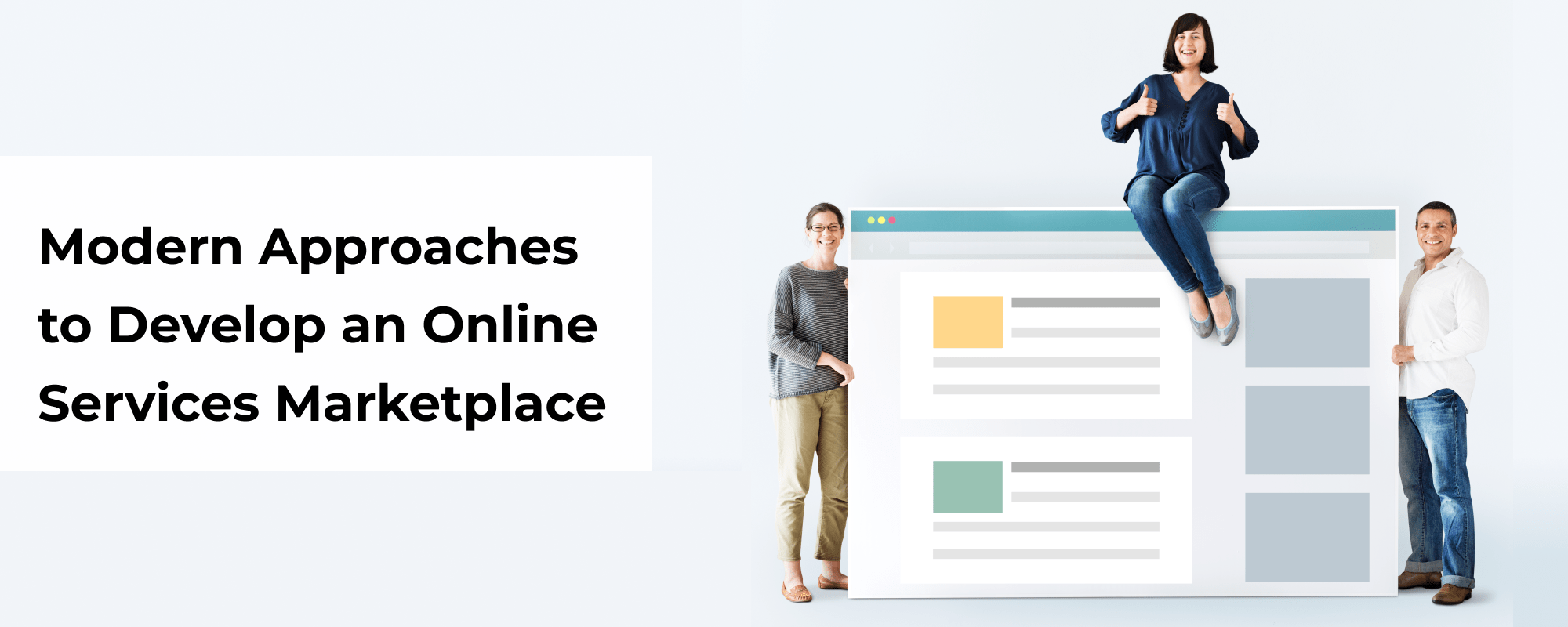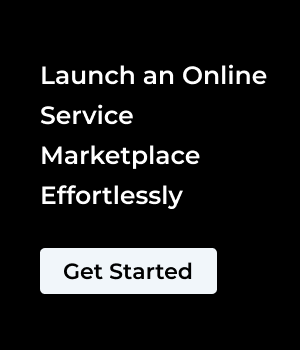Last Updated: January 03, 2024
In today’s digitally-enabled world, a wide majority of service industry professionals operate offline. They are fragmented at a level where it is arduous for them to reach new customers, eventually clipping off many growth opportunities. As a result, their services stay limited to hyperlocal despite having an impressive work portfolio and the potential to grow. Online service marketplace platforms solve this problem for service providers by providing a platform dedicated to helping them find more work and recognition.
Table of Contents:
What is an Online Services Marketplace?
Also referred to by various terms – such as a handyman marketplace, gigs marketplace, and freelancer marketplace on the internet, an online services marketplace is a platform that allows multiple service providers to register themselves and sell their services online. These services can range from blue-collar jobs, such as plumbing, carpentry, electrician, and gardening to white-collar or common freelancing jobs such as digital marketing, graphic designing, branding and content writing.
Key perks of joining an online services marketplace platform for service providers include access to a wider audience, increased online presence, payment security, and flexibility in terms of deciding their own rates and schedules. Some services marketplaces also have a reverse search option where customers upload a task and service providers place their bids for getting the job. These marketplaces add the benefit of autonomy for service providers who get more freedom in job selection.
In this article, we have shared more insights to help you start an online service marketplace. After reading this article, you will understand the operational model of online service marketplaces and the best method to develop one.
Key Growth Drivers in the Online Services Industry
As per statistics, the handyman services market alone is expected to grow at a CAGR of 17.2% in the period 2022-2032. In terms of digits, this amounts to a growth of $1.31 billion over the previously recorded $339 million, totalling $1.65 billion. The growth rate for the freelance service platforms market is equally impressive. At an estimated figure of a whopping $18.3 billion by 2031, the freelancers platform market is growing at a CAGR of 15.1% in the forecast period 2023-2031.
While the growth rate for both the handyman and freelancing industries is vividly astonishing, a wider aspect is required to understand the business potential in the overall online services industry. For instance, let’s take an overview of the primary growth factors that back the aforementioned growth statistics:
- Convenience: Hiring a service provider on a service marketplace platform is highly convenient for customers. They can browse different platforms, see service provider profiles, compare rates, ratings, and portfolios to make a more informed decision. Some online service marketplaces also provide discounts to make services more affordable.
- Commercial and Residential Renovation Projects: Metropolitan cities, urban cities, suburban areas and even rural areas have many structures aged 20 to 100 years. These structures require timely renovation and repair work to fix any plumbing, sewage, HVAC and electricity problems.
- Regular Servicing and Maintenance of Appliances: Electric appliances, automobiles, heavy equipment and power tools require regular servicing and maintenance to ensure efficiency. With online service marketplaces, consumers can hire engineers and mechanics directly through the internet.
- Technological Advancements: Installation of new technologies, such as electrical systems, security systems, house automation appliances, solar panels, etc. also requires handymen and certified service professionals.
- Digital Transformation: The surging demand for digital services such as digital marketing, branding, programming, content writing and graphic designing is the key driver behind the growth of freelancing platforms and marketplaces.
Incumbents in the Online Services Industry
The online services industry is still in its nascent stages and is yet to see exponential growth. However, there already exist well-established businesses that have captured enormous market size. Entrepreneurs interested in launching a service marketplace platform can take reference from these businesses:
| Apps |
Launch Year |
Estimated Revenue |
| Angi |
1995 |
$1.6 billion |
| Bark.com |
2014 |
$455 million |
| Thumbtack |
2008 |
$300 million |
| TaskRabbit |
2008 |
$245 million |
| Handy |
2012 |
$216 million |
| HomeAdvisor |
1998 |
$483 million |
| BuildZoom |
2011 |
$128.6 million |
| Houzz |
2009 |
$379 million |
| HomeX |
2017 |
$101 million |
Find the Journey of Aforementioned Service Marketplaces Inspiring?
Approaches to Build an Online Services Marketplace
Launching a digital venture encompasses more than having a digital touchpoint or platform to conduct operations. It further extends to having access to the right set of digital tools at your disposal to help you manage and streamline operations in time. Likewise, having a well-designed platform also cannot be overlooked. A user-intuitive and aesthetic platform incentivizes visitors to engage more and is more likely to convert. Based on this information, entrepreneurs are required to understand the operational model of an online services marketplace along with the key elements needed to launch one.
Operational Model of an Online Services Marketplace
The following operational model is only for exemplary purposes. The actual model can vary from business to business and you may also need to customize the operational model as per your business preferences.
- Service providers sign up on the online services marketplace and create profiles
- Customers browse service provider profiles and review their ratings, reviews and portfolio
- With the help of a scheduling calendar, customers view provider availability and book an appointment
- Additionally, customers can also state the job in a comment box for the service provider’s reference
- Customers select the address at checkout and complete the payment
- Service providers coordinate with customers to complete the job
- Post completion, customers rate the service providers
Alternatively, some online service marketplaces also allow customers to create jobs that service providers can search and place bids. The rest of the model remains the same.
Important Features and Functionalities Required on the Service Marketplace
Having three user-types, which are the admin (marketplace owner), service provider and customer, an online services marketplace requires a separate set of features for all these user-types.
| Admin |
Service Provider |
Customer |
| Order management (view and edit orders) |
Social media login and sign-up options |
Social media login and sign-up options |
| User management (view, edit, block and remove user profiles) |
Profile management (create, view, edit and remove profile) |
Appointment scheduling calendar |
| Payment gateway management |
Portfolio management (upload, view and edit portfolio) |
Profile management (create, view, edit and remove profile) |
| Portal management (create, edit and remove web pages) |
Order management (accept, reject, view and mark orders) |
Job/task management (create, view, edit and accept bid) |
| Commission management (set and edit commission rates) |
eWallet (view and withdraw earnings) |
Alerts and notifications |
| SEO management (image alt tags, page URLs, meta descriptions, and more) |
Bidding management (view jobs, place bids and review bids |
Chat module |
| Discounts and promotions |
GPS routing |
Multiple payment options |
| Data analytics and reports |
Chat module |
Rate and review service providers |
| Alerts and notifications |
Rate and review customers |
|
| Ratings and reviews management |
Alerts and notifications |
|
Create a Feature-Loaded Service Marketplace Platform
Revenue Generation Model of an Online Services Marketplace
Being an online platform, an online services marketplace owner can diversify income from various revenue streams:
- Job commission
- Featured listings
- Display ads
- Subscription packages
Important Web Pages to Set Up
To start your online services marketplace and conduct full-fledged operations, entrepreneurs are required to set up the following webpages:
- Home page
- Sign up page
- Service provider registration
- Find a handyman
- Post a job
- Job listings
- Admin dashboard
- User dashboard
- Service provider dashboard
- About us
- Contact us
- How it works
- FAQ
- Blog
- Testimonials
- Terms of service
- Privacy policy
- Reviews and portfolio
- Customer support
You can bookmark this article to save the features and webpages list. After having a complete idea of primary requirements, entrepreneurs can decide to build their online services marketplace or buy readymade software for the same.
Approach 1: Building An Online Services Marketplace or Bespoke Development
The first approach to building an online service marketplace platform is to rely on the traditional Software Development Lifecycle (SDLC) framework. This framework defines the various processes and stages of software development including design, development, testing, implementation, and maintenance. SDLC helps software developers identify key requirements, organize source code, eliminate low-quality code, and maintain the development budget.
Even in SDLC, there are two popular methodologies:
1. Waterfall Development Methodology
The waterfall development methodology follows a linear approach to development where each and every phase of the methodology depends on the outcome of the precious phase. Meaning, at one time, developers can only work with a predefined set of requirements. To fulfill any additional requirement or introduce changes in the initial requirements, the software development team will have to restart the entire development process. As returning to a previously closed phase is not possible in the waterfall methodology, entrepreneurs and business analysts are required to carefully prepare BRD, SRS and FRS documents.
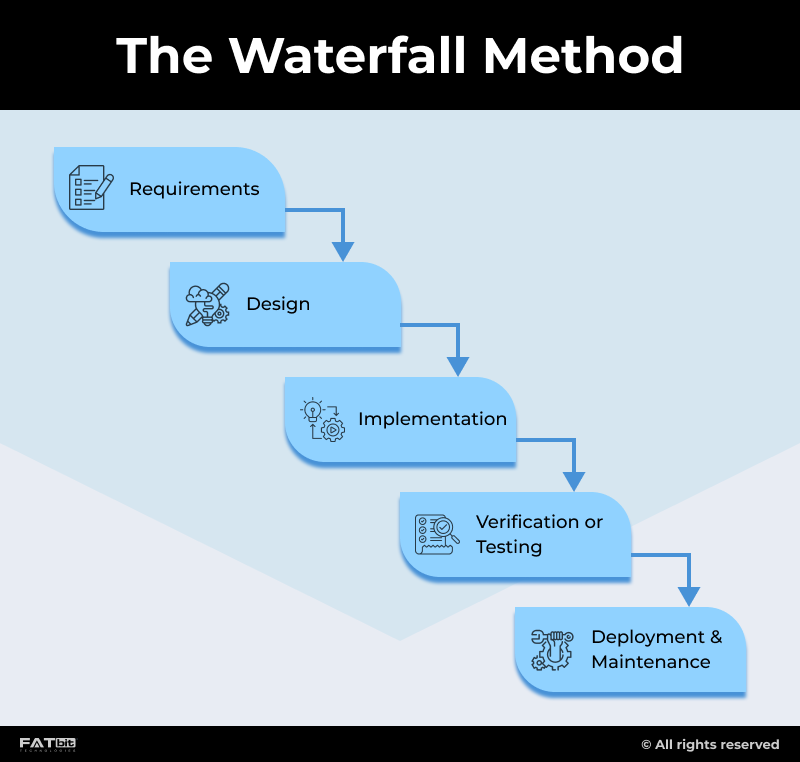
Pros of Using the Waterfall Methodology
- It is very easy to follow
- Has a specific development timeframe and deliverables
- There are no to minimum project overhead costs
- Testing is easy considering project requirements always remain the same
- Highly cost effective in compared to other bespoke software development approaches
- Timelines are easy to meet
- Outcomes are clear right from the start
Cons of Using the Waterfall Methodology
- Requirements once defined cannot be changed
- Not possible to return to previously complete development phase
- The end-product can lack essential features, resulting in the development of an outdated software
- Longer delivery timeline
- The client can only review the software post completion of project
2. Agile Development Methodology
The agile development methodology reduces the delivery timeline of the software by breaking the software into multiple development sprints. In contrast to waterfall development, agile also does not require a complete set of requirements to begin. Instead, the project starts with bare minimum requirements or with the development of an MVP software and then more features are added based on early adopter feedback. This process of improving the software based on early-adopter feedback in multiple repetitions is also known as iterative development.
As new features can be introduced between two different sprints of the project, there’s no need to have a predefined set of features and entrepreneurs with just a vision can opt for agile development.
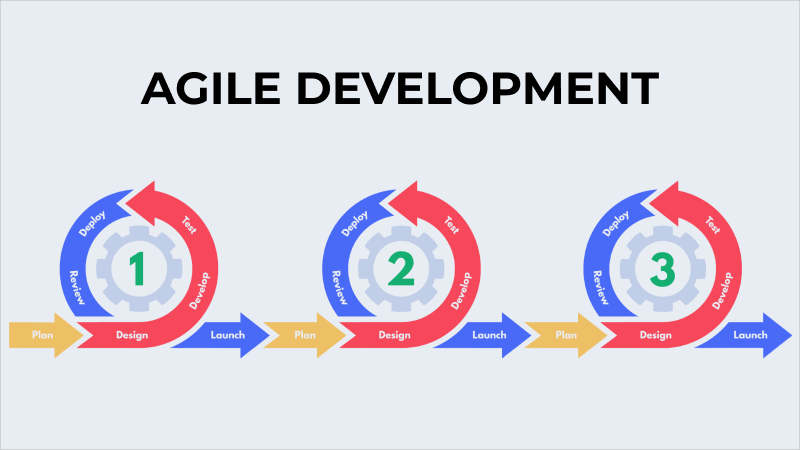
Pros of Using the Agile Development Methodology
- Introducing changes in the development project is easy because of multiple short sprints
- A sprint only lasts 2-4 weeks, after which the client can review the software and see the direction towards which the development is headed
- Makes it easy to test or validate a business idea
- Improves the software based on early-adopter feedback and iterative development
- Does not require a predefined set of requirements. Due to this, agile methodology is highly suitable for entrepreneurs who are not sure about the features of the software
- Helps businesses stay up-to-date with their software technology
Cons of Using the Agile Development Methodology
- As software development primarily relies on early adopter feedback, the final outcome can vary from the client’s expectations
- While delivery timelines are short, developing a full-fledged software can take more time with agile development
- Very costly in the long run
- Requires arduous project planning and time commitment
Waterfall Development vs Agile Development
| Waterfall Development |
Agile Development |
| Develops the entire software in one go |
Software development is divided into multiple sprints |
| Introducing new changes is not possible in the software |
New changes can be introduced after each and every sprint |
| Cost and time effective |
Not so cost effective in the long run, but highly time effective because of multiple sprints |
| Software developed in not up-to-date |
Software developed is up-to-date with all latest features |
| Requires predefined features |
A set of predefined features is not required |
| Cannot be used to test new business ideas and markets |
Can be used to test new business ideas and markets |
| More suitable for small-sized businesses |
More suitable for medium-to-large size businesses |
Both waterfall and agile development approaches are useful software development methods. However, in today’s time, using readymade solutions is more reliable because of multiple reasons that we have discussed below.
Approach 2: Buying a Readymade Services Marketplace Software
The second approach emphasizes saving both time and capital by investing in an off-the-shelf, readymade online services marketplace software. Such type of software comes with all necessary features right out of the box. Additionally, these features are already tried and tested in various markets to ensure business feasibility and performance. In comparison to building a service marketplace from scratch, using a ready-made software is more cost effective and time-saving. Even in the readymade software category, there are two popular types of software:
1. Self-Hosted Software
These software are hosted on the business owner’s own choice of server. Meaning, the server can be both on-premise or a third-party hosting service. The key benefit of using self-hosted software is that entrepreneurs can select a more secure or faster server for themselves. Their selected server can be a shared or private server as well, giving them complete control over the software.
Pros of Using Self-Hosted Software
- Business owners get the choice of hosting
- Due to choice of hosting, business owners get complete control over the software
- Self-hosted software also come with one time costs
- There are rarely any limitations on features and number of users
- Highly scalable and cost-effective in the long run
Cons of Using Self-Hosted Software
- The one-time cost can be too much for small startups and solopreneurs
- Due to no cap on features, the software can look too overwhelming
2. SaaS Software
You can also start an online services marketplace with the help of SaaS software. The term SaaS refers to Software-as-a-Service. In this type of readymade software, the online platform is hosted on the software provider’s server and provided to the business owner as a monthly service. As the server is not owned by the business owner, he does not get complete control over the software and has to adhere to the software provider’s terms and conditions.
Pros of Using SaaS Software
- Monthly recurring payments make SaaS software highly suitable for small startups and solopreneurs
- Often gets timely updates and changes
- Comes with multiple subscription package to choose from
Cons of Using Self-Hosted Software
- Business owners do not get complete control over the software
- The number of listings, users and transactions is often limited
- Not scalable. Monthly costs increase with time
- Access to all features is only provided in the most expensive package
| Self-Hosted Software |
SaaS Software |
| Hosted on the business owner’s choice of server |
Hosted on the software provider’s own servers |
| One time cost |
Monthly recurring costs |
| Come with all features fully unlocked |
Features are divided into multiple subscription packages. Only the most premium package gives access to full features |
| No cap on users, transactions and listings |
Number of users, transactions and listings can be limited |
| Highly cost-effective in the long term |
Only cost-effective in the short term. Costs tend to add up with time and business growth |
Our Recommendation:
For launching a service marketplace platform, our recommended readymade software is Yo!Gigs. It is a full-fledged self-hosted service marketplace solution that comes with three different dashboards for streamlining operations:
- Admin Dashboard – Advanced order management, user management and platform management features to help the business owner manage service marketplace operations
- Service Provider Dashboard – A single place from where service providers can view their earnings and pending jobs
- Customer Dashboard – For customers to view their booked orders and coordinate with service providers.
Through Yo!Gigs, business owners can connect hundreds of service providers at one place and launch a one-stop destination for finding handyman professionals. Some other reasons to invest in Yo!Gigs service marketplace software are:
- Trust of FATbit Technologies
- Available at one-time cost
- Comes with 1 year of free technical support
- Fully scalable and customizable
See Yo!Gigs in Action in a Personalized One-on-One Demo
How to Start an Online Services Marketplace: Build or Buy?
Based on the aforementioned information, we can come to the conclusion that both building and buying a services marketplace have their own benefits. Still, considering the huge cost difference between the two approaches and the easy availability of advanced technological solutions, buying a tried and tested ready-made on-demand services marketplace solution makes more sense. On the contrary, bespoke development is practical in situations where entrepreneurs have very unique requirements or want their service marketplace platform to be built on a very specific technology.
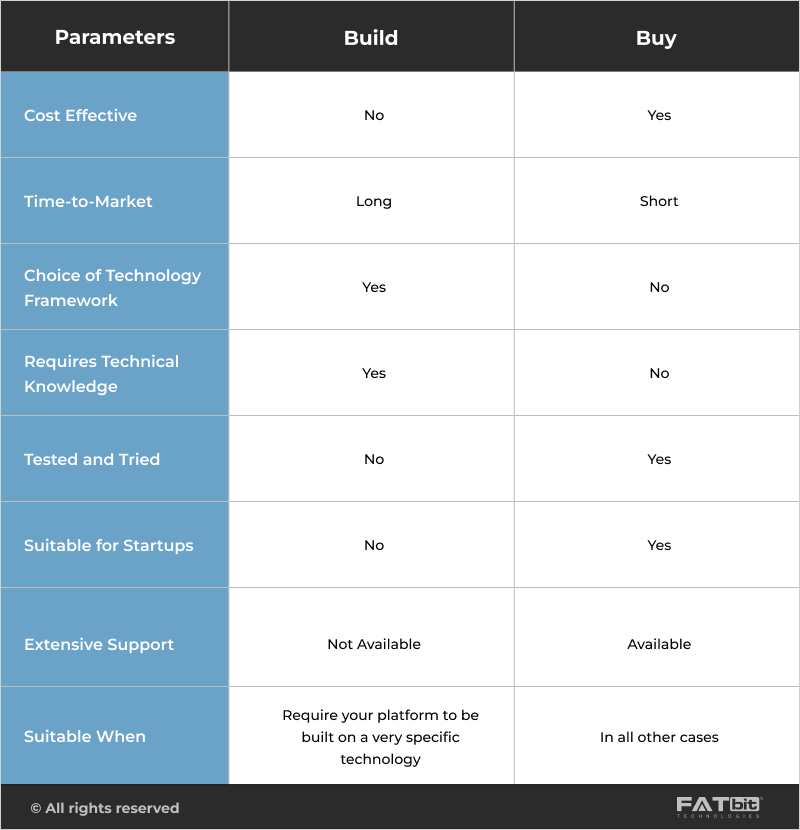
Conclusion
Any business idea only reaps results when adequate efforts are put in the right direction. While an online service marketplace is an asset-light business idea, it will still require efforts on two important fronts, which are technology and management. While powerful technology will help you simplify operations for both customers and service providers, appropriate management will drive you toward your overarching goals. In the initial stages, you may also need to invest money and time in marketing but once you onboard service providers, it’d be easier to grow your services marketplace business.
FAQs
Q1. What is the key difference between building and buying a service marketplace software?
Ans: Although both building and buying options are available to founders, for the most time and cost-effectiveness, buying is a better option. This is because of three primary reasons:
- In ready-made software, every feature and functionality is already present. With custom development, you need to develop everything from scratch, which can take up to months.
- Readymade software is either available at SaaS pricing or at a one-time cost. Custom development includes hourly development rates, which makes this approach highly cost-inclusive.
- As all the features in readymade software are already tried and tested, they make it a better option to build your online service marketplace platform.
Q2. Can I develop a service marketplace platform like Angi, Bark, and Taskrabbit with readymade software?
Ans: The answer is yes. Service marketplace software comes with in-built support for business models like Angi, Bark, and TaskRabbit. You can easily onboard service providers and customers and let them connect. Furthermore, readymade software also allows you to manage service providers and set your commission rate. With a plethora of similar features that streamline marketplace management, building a platform like Angi and TaskRabbit is possible with readymade service marketplace software.
